Plants interact with their environments above and below ground, shaping their growth, health, and adaptability. Decoding these interactions at a biological level is key to driving sustainable agriculture, but field-based systems have long struggled to measure such complexities at scale.
The Automation and Sensing team integrates above and below ground robotics, nanotechnology, and advanced computing to decode plant communications. These innovations will provide real-time, plant-driven decision-making in agriculture, where plants signal their requirements or are provided triggers that generate a plant response. The tools and models developed through this work lay the foundation for a more resilient future in agriculture.







